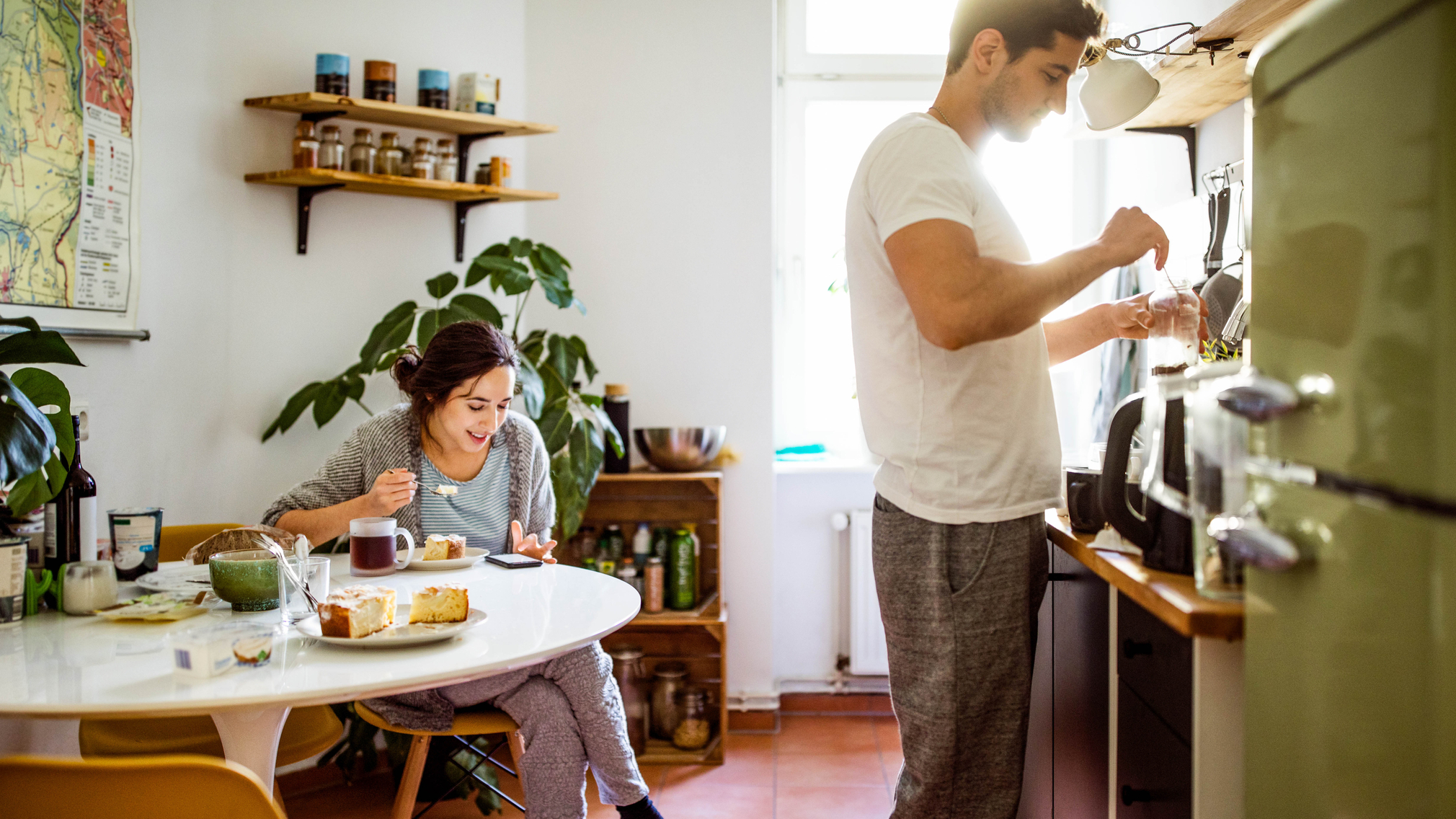How Much Are Utilities in an Apartment?


Written by Shawnna Stiver on June 27, 2025
The median cost of utilities in an apartment in the United States is approximately $150 per month, according to the 2023 American Community Survey. Keep in mind, some landlords may include utility fees in the rent payment. This average typically reflects the 90% of renters who pay their utilities separately from rent.
When budgeting for their next rental, use this guide to help you plan for your apartment utility costs, explore factors that could affect these costs, and identify which utilities landlords typically cover.
Average monthly costs for basic utilities
For the top five cities in the U.S. with the highest population of renters (New York, Los Angeles, Chicago, Dallas, and Houston), the average monthly cost for basic utilities, including electricity, water, gas, and heating, ranges from $110-$170.
When it comes to utilities, there’s no one-size-fits-all answer. Key factors like apartment size, location, and usage significantly influence costs. Here’s an estimate of the average monthly utility costs for an apartment rental.
Electricity: $70-$190 per month
Electricity tends to make up the largest portion of your utility bill. It powers everything from appliances to lighting, and in many cases, heating and cooling.
Smaller apartments consume less energy, while larger ones with more occupants and appliances naturally lead to higher bills. Climate also plays a role in your electricity bill. In hotter areas, like Dallas, TX or Phoenix, AZ, your monthly electricity costs may be $80–$90 higher for up to eight months of the year due to the cost of air conditioning.
Water: $17-$63 per month
Your water bill reflects the amount of water consumed, whether through showers, dishwashers, or simply washing your hands. Costs may vary depending on your city’s billing policies, with higher rates often found in arid or metropolitan areas.
For example, people living in the Midwest might pay less for water due to proximity to abundant freshwater sources, while those living in California often pay a premium to conserve this limited resource.
Gas and heating: $40-$100 per month
Gas is commonly used for hot water heaters, stoves, and sometimes apartment heating. If your apartment relies on gas for multiple utilities, you can expect the cost of gas to fall toward the upper end of the $40-$100 range, particularly in colder seasons when heating becomes a priority.
Trash and recycling: $7-$50 per month
Trash and recycling services, while relatively minor in cost, are essential for maintaining a clean and hygienic living environment. The average person living in an apartment generates around 2.5 pounds of waste per person or 8 pounds per unit. Since trash and recycling costs are usually variable depending on the size of your container, the fees may be vastly different from one unit to the next. Some buildings include trash and recycling services in the rent, but many separate them. Recycling, in particular, may come at an additional charge in areas with stricter sustainability regulations. Some apartment communities may also require a valet trash service in your lease agreement, which can range from $25 to $50 a month. Eighteen percent of renters in a 2024 Zillow survey reported paying for valet trash.
Average monthly costs for additional utilities
Beyond basic utilities, renters might also encounter additional costs for services like sewer, pest control, internet, and cable. These expenses may or may not be included in rent, so it’s important to confirm with your landlord.
Sewer: $20-80 per month
Sewer services ensure wastewater is safely treated and disposed of, contributing to the sanitation of your home. The monthly sewer rate can vary by location, peak usage seasons and whether additional capacity charges apply. For example, the average monthly cost for sewer expenses in a 2-bedroom apartment in Des Moines, IA is $25.67, while the same size unit in Seattle, WA is around $65 per month.
Pest control: $2-$20 per month
Depending on your building and lease agreement, pest control may be a shared expense with your landlord, or you may need to pay for it yourself. In a 2-bedroom apartment in central Iowa, pest control costs around $2.07 monthly but may increase significantly for higher-risk properties. In a more expensive area like Seattle, WA, pest control for the same size may be as high as $70 per month.
Home connectivity services: $42-$88 per month
Internet, cable TV, and streaming services are optional but common expenses for most households. You’ll want to factor these home connectivity services into your monthly apartment expenses. Here’s how much U.S. consumers spend on average for these services each month, according to the 2024 State of Consumer Media Spending report:
- Internet: $69.43 per month
- Streaming services: $42.38 per month
- Cable TV: $88.94 per month
Bundling some of these services can help save on costs, while ensuring you stay connected to the digital world.
What utility costs are usually covered by a landlord?
Some landlords may include utilities in the cost of rent, rather than bill tenants separately. Water, trash and heating are some of the more common utilities to be covered by landlords in these situations. Of course, the type of utilities a landlord may cover depends on what is specified in your lease agreement. The location of the rental property and type of rental may also determine whether a landlord covers utility costs.
Some multi-unit buildings with shared meters, for instance, may require landlords to cover the cost of utilities or split the cost evenly among tenants. Be sure to reference your lease agreement to avoid any surprise expenses. Before signing a new lease, clarify any utility costs with the landlord. You should also check local laws, as some states and cities have regulations about utility costs.
Factors that affect utility costs
Utility costs may vary by location, number of occupants, energy efficiency, and several other key factors. Here’s a list of the more common factors that may impact utility costs in an apartment:
Location
Your geographic location plays a significant role in utility pricing. Cities like New York, NY, or Los Angeles, CA, often have higher utility costs compared to smaller cities in the Midwest. When comparing the top 50 metropolitan cities in the U.S., these are the two cities with the lowest monthly cost versus the highest.
- Memphis, TN: holds the title for the highest average utility costs at $213 per month.
- Minneapolis, MN: came in as the lowest with an average monthly cost of $87 for utilities.
Size of apartment
The larger your apartment, the more your HVAC system and appliances have to work, driving energy costs higher. For example, average utility costs for a large, single-family rental can reach $250, while apartments in buildings with 20+ units average around $90.
Number of occupants
The more people living in your apartment, the more resources like water and electricity get consumed, increasing monthly expenses. A family of four will naturally use more utilities compared to a single occupant in a studio.
Seasonal demand
Utilities fluctuate with seasons. Summer typically spikes energy consumption due to air conditioning, particularly in warmer regions like Arizona or Texas, where A/C usage significantly pushes electricity bills higher. Conversely, winter increases heating costs, especially in colder regions like Minnesota or Michigan.
Energy efficiency
Apartments outfitted with energy-efficient perks, such as smart home technology or low-flow plumbing fixtures, are better equipped to minimize utility consumption. While older, less-insulated buildings often lead to more expensive heating and cooling costs.
Personal habits
From leaving lights on to running appliances unnecessarily, everyday habits impact your utility bills. Making small adjustments, such as unplugging devices not in use or using energy-efficient lighting, can significantly reduce costs.
Key takeaways for renters
Managing utility costs while renting involves understanding what’s included in your rent, monitoring your usage, and factoring in external conditions like location and climate. In a recent Zillow survey, 64% of renters who paid a utility fee to their landlord or property management company said they did not have the option to pay utility companies directly — implying most renters paid the property owner directly. To keep your bills manageable:
- Confirm which utilities your landlord covers, and make sure your lease agreement reflects those details accordingly.
- Compare alternative service providers for internet and home connectivity.
- Employ energy-saving practices, like using fans instead of A/C or unplugging unused electronics.
- Finally, renter’s insurance is a great way to prepare for the unexpected. Request a renters insurance quote from Zillow to get coverage in less than five minutes.
Planning ahead ensures you’re prepared for utility costs, making your living situation stress-free and within budget.
Find an apartment you’ll love on Zillow
With Zillions of up-to-date listings and filters for your must-haves, it's easy to find your perfect apartment on Zillow Rentals.
Search rentals

